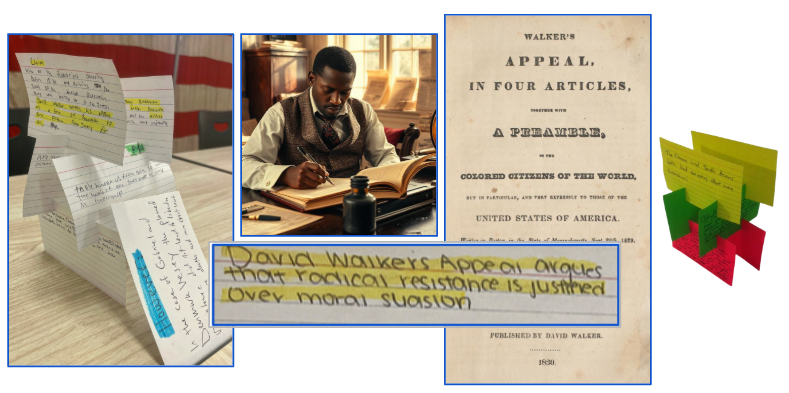2.19 Black Political Thought: Radical Resistance
David Walker Argument Tower: Justification for Radical Resistance
LO 2.19.A Describe the features of nineteenth-century radical resistance strategies promoted by Black activists to demand change.
". . . kill or be killed. Look upon your mother, wife and children, and answer God Almighty; and believe this, that it is no more harm for you to kill a man who is trying to kill you, than it is for you to take a drink of water when thirsty." - David Walker, Appeal, Article III
Walker's Appeal was the first sustained written assault upon slavery and racism to come from a black man in the United States. The Appeal influenced Frederick Douglass, Nat Turner, William Lloyd Garrison, Martin Luther King Jr., and Malcolm X...” Walker does this not as one who hates the country but rather as one who hates the institutions which disfigure it.” - Historian Dr. Herbert Aptheker
Objective: Students will collaborate to construct an argument justifying radical resistance to slavery over the moral suasion approach used by other abolitionists. They will achieve this by analyzing and summarizing the central claims presented in David Walker’s Appeal.
NOTES
At the end of the year during the pilot, I asked students to rank the top five essential AP African American Studies documents. Walker’s Appeal came in second, just behind The Ballot or the Bullet. I believe the argument tower activity contributed to this ranking, as it was the only first-semester document to make their list. (That, along with the sheer power of Walker’s message, of course!)
The argument tower approach has been a staple in AP History classrooms for years, but I only started using it a couple of years ago. Now, I absolutely love it! I’ve added a few steps to incorporate context and argument modification, and these additions have dramatically accelerated students' growth in essay writing. After adopting this method, I began receiving “March-quality” essays as early as November (if that makes sense). I now use it in both AP U.S. History and AP African American Studies.
The most effective aspect of the tower is its ability to help students visualize the DBQ rubric. While students generally grasp the idea of making a claim and backing it up with evidence, the harder part is teaching them to write that essential next step: explaining why and how the evidence supports their claim.
Pro tip: Cut the note cards ahead of time! I used to hand out scissors and blank note cards, thinking it would save time. It didn’t—possibly because I wasn’t great at explaining where to make the cuts. Now, I precut the cards myself, which only takes about a minute and eliminates confusion.
Lesson Plan
Print the handout (back-to-back) for all students. I keep them separate and don’t staple them.
Spend 7-8 minutes introducing the Moral Suasion strategy for abolishing slavery (or, as one of my students called it, “the thoughts and prayers approach”). Have students follow along with slides #2-8 with the simple fill-in-the-blank on page 3 of the handout. This reviews the basic history of abolitionism in the U.S., including its emphasis on gradualism and colonization.
William Lloyd Garrison was considered a “radical” by most abolitionists because he advocated for immediate abolition; however, his approach was moral suasion.
Emphasize (the slides do this as well) that Garrison made his appeal to enslavers.
Read the quotes by Garrison and Frederick Douglass. Note that Douglass eventually came around to the wisdom of David Walker about a decade before Garrison did.
Intro to David Walker: (3 minutes) Use slides #9-12 to provide a brief background on Walker. Be sure to note the significance of the difference in his target audience compared to that of Garrison and Douglass.
Reading and Argument Tower Construction (35-40 minutes): Focus less on the technicalities of the argument tower process and more on getting students to dive into the text and discuss Walker’s use of claim-evidence-reasoning with each other. Writing on the note cards and tower construction can actually be done in the last 15 minutes of class.
Slide #14 has simplified instructions. Students also have a full set of instructions on the back of the Garrison and Douglass quotes. Most groups can figure this out with the instructions, but make sure to actively rotate around the classroom to confirm everyone understands.
You can complete this activity within a 55-minute class.


